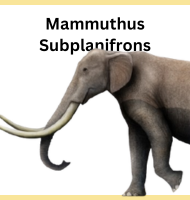Mammuthus Subplanifrons
Not the most famous of the mammoths, M. subplanifrons still remains the earliest known species of the genus with some of the more famous species such as M. primigenius (woolly mammoth) and M. columbi (Columbian mammoth) not appearing until much later in the Pleistocene era. The most obvious feature that reveals M. subplanifrons to be a mammoth are the spirally twisting tusks … Read more
